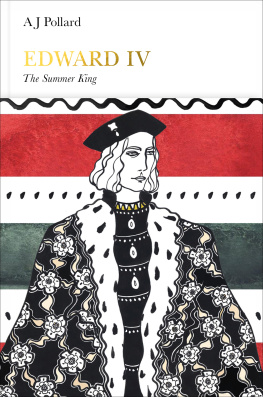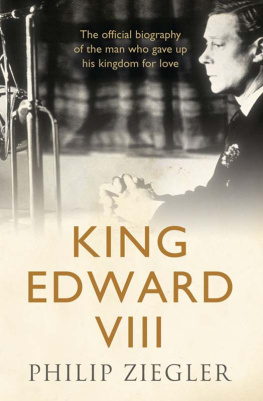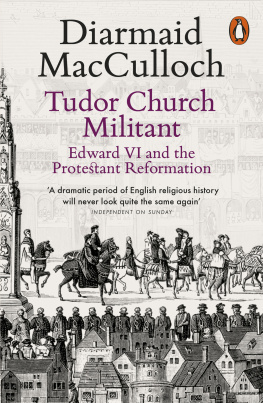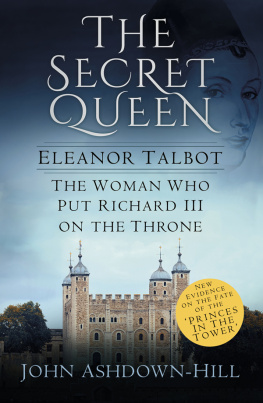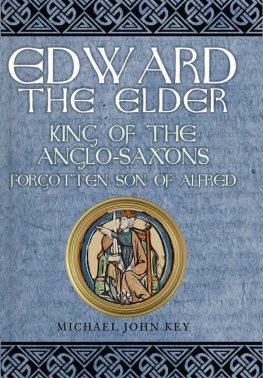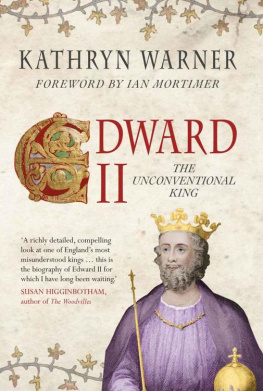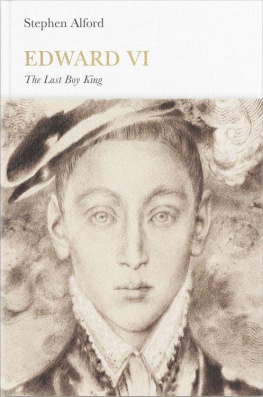Contents
A. J. Pollard
EDWARD IV
The Summer King

ALLEN LANE
UK | USA | Canada | Ireland | Australia
India | New Zealand | South Africa
Penguin Books is part of the Penguin Random House group of companies whose addresses can be found at global.penguinrandomhouse.com.
First published 2016
Copyright A. J. Pollard, 2016
Cover design by Pentagram
Jacket art by Rosie McGuinness
The moral right of the author has been asserted
ISBN: 978-0-141-97870-3
THE BEGINNING
Let the conversation begin
Follow the Penguin Twitter.com@penguinUKbooks
Keep up-to-date with all our stories YouTube.com/penguinbooks
Pin Penguin Books to your Pinterest
Like Penguin Books on Facebook.com/penguinbooks
Listen to Penguin at SoundCloud.com/penguin-books
Find out more about the author and
discover more stories like this at Penguin.co.uk
Penguin Monarchs
THE HOUSES OF WESSEX AND DENMARK
| Athelstan | Tom Holland |
| Aethelred the Unready | Richard Abels |
| Cnut | Ryan Lavelle |
| Edward the Confessor | James Campbell |
THE HOUSES OF NORMANDY, BLOIS AND ANJOU
| William I | Marc Morris |
| William II | John Gillingham |
| Henry I | Edmund King |
| Stephen | Carl Watkins |
| Henry II | Richard Barber |
| Richard I | Thomas Asbridge |
| John | Nicholas Vincent |
THE HOUSE OF PLANTAGENET
| Henry III | Stephen Church |
| Edward I | Andy King |
| Edward II | Christopher Given-Wilson |
| Edward III | Jonathan Sumption |
| Richard II | Laura Ashe |
THE HOUSES OF LANCASTER AND YORK
| Henry IV | Catherine Nall |
| Henry V | Anne Curry |
| Henry VI | James Ross |
| Edward IV | A. J. Pollard |
| Edward V | Thomas Penn |
| Richard III | Rosemary Horrox |
THE HOUSE OF TUDOR
| Henry VII | Sean Cunningham |
| Henry VIII | John Guy |
| Edward VI | Stephen Alford |
| Mary I | John Edwards |
| Elizabeth I | Helen Castor |
THE HOUSE OF STUART
| James I | Thomas Cogswell |
| Charles I | Mark Kishlansky |
| [ Cromwell | David Horspool ] |
| Charles II | Clare Jackson |
| James II | David Womersley |
| William III & Mary II | Jonathan Keates |
| Anne | Richard Hewlings |
THE HOUSE OF HANOVER
| George I | Tim Blanning |
| George II | Norman Davies |
| George III | Amanda Foreman |
| George IV | Stella Tillyard |
| William IV | Roger Knight |
| Victoria | Jane Ridley |
THE HOUSES OF SAXE-COBURG & GOTHA AND WINDSOR
| Edward VII | Richard Davenport-Hines |
| George V | David Cannadine |
| Edward VIII | Piers Brendon |
| George VI | Philip Ziegler |
| Elizabeth II | Douglas Hurd |
For Scarlett
Preface
Edward IV was a usurper. In 1461, aged eighteen, he seized the throne from Henry VI during the course of the first and most fierce of the Wars of the Roses between his house and the house of Lancaster. His father, Richard, Duke of York, had claimed to be the legitimate king; Edward made good the claim with the sword. Edward struggled at first to hold on to power and was deposed in 1470. Six months later, in the spring of 1471, he dramatically recovered his crown. Uniquely among English monarchs, Edward IV had two reigns. After 1471 he appeared to have secured the throne for himself and his heirs. However, his early death in 1483 led rapidly to the collapse of his dynasty and its replacement by the Tudors. There have been few more dramatic stories in the history of the English monarchy than the rise and fall of the house of York.
Historians are divided as to whether Edward himself is to be blamed for the ultimate failure of his dynasty. Almost from the moment of his death alternative views were being expressed for and against him. Within twenty years a debate concerning the character of the man and the quality of his rule was established with which all subsequent historians have had to engage. This debate, set out in the first chapter, has not been as passionate as that surrounding his brother Richard, Duke of Gloucester, later Richard III, but it has likewise shaped and constrained the way his history is written. Modern judgements of him have ranged from an immoral hedonist and bloody tyrant to a hard-working exemplar of the ideal of a medieval monarch. Within this spectrum, he is in this book characterized nearer the former than the latter, as a ruler who rarely looked beyond the short term, his own close circle and his own immediate ends. Though capable of sustained attention to statecraft, especially in a crisis, as his reign progressed and he aged he became more addicted to self-indulgence. In several respects he was successful, but he failed to establish his dynasty. Yet ill-fortune also played a part. Had he lived for just four more years (he was not yet forty-one when he died in 1483), his elder son would have succeeded him without challenge. It is likely that Edward would then have been remembered as a successful monarch, possibly the founder of a great dynasty. As it is, today he hardly registers in the public imagination, overshadowed by his notorious brother Richard who took the throne for himself.
Edward deserves to be better known for the drama of his life, his flamboyant personality and the way in which his reign witnessed a revival in royal authority completed by Henry VIII. I hope this brief account will bring him to a wider readership. I would like to thank Tom Penn for asking me to write the book. I have written several times in different contexts on the reign of Edward IV, but never before have I had the opportunity to make the man and monarch centre-stage. I have benefited over a lifetime from the research, assistance and advice of many fellow historians, too many to list, but I would particularly like to acknowledge my debt in this work to Charles Ross and Michael Hicks. I would also like to thank Tig Lang, Hugh Meller and Michael Stansfield for their help on particular matters and all the staff at Penguin in going to press. Finally, Sandra, thank you for your loving support during a difficult time while this book was being written.

